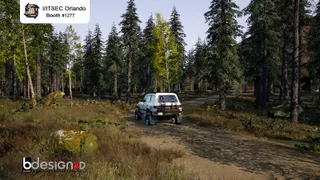Waking up to Simulation
Contact Our Team
For more information about how Halldale can add value to your marketing and promotional campaigns or to discuss event exhibitor and sponsorship opportunities, contact our team to find out more
The Americas -
holly.foster@halldale.com
Rest of World -
jeremy@halldale.com

In an evolving threat landscape, MilSim Asia showcased the present and future value of S&T technologies. Kate Warner reports from Singapore.
Against the backdrop of a rapidly evolving geopolitical landscape, this year’s MilSim Asia conference at the Marina Bay Sands in Singapore in January was a timely opportunity for the emerging simulation nations of the Asia-Pacific region to see and hear how other countries are using immersive technologies to enhance force readiness.
MilSim Asia was one of four technical conference streams in the Asia Defence Expo & Conference Series (ADECS), the others being Electronic Warfare Asia, Undersea Defence Technology Asia and Maritime Patrol Asia. Whilst there are many advantages to being bundled like this, it highlights the need to draw more delegates to the event and the relative immaturity of the region’s technology-for-training mindset.
It turns out, however, that Asia’s relatively late entry into the simulation game comes with benefits. Whilst MilSim Asia’s stated focus was looking at the next generation of simulation and training technologies and their application, other themes to emerge included the mutual benefits of closer cooperation between allies in the Asia-Pacific region, and the myriad of lessons learned by Asian nations from the early adopters of simulation inside and outside of Asia.
“Asia is in the fortunate position of being able to learn from the history of the US in that they don’t have old ‘legacy’ systems to deal with,” said Cory Kumm, senior vice president of Corporate Development at Bohemia Interactive Simulations. According to Kumm, who has been working in the simulation field throughout Asia for more than 10 years, the US is about a decade ahead of Asia in terms of simulation adoption. This puts Asia in a powerful position to be able to learn from the mistakes of the more advanced simulation nations.
“The US has invested hundreds of millions of dollars over the last 10 years, initially in full-scale simulators that weren’t capable of interoperating with other training facilities,” said Kumm. “Not only are these simulators expensive to install, but they’re expensive to operate and can only train small numbers of people at any one time. And now they’re reaching the end of their life. It’s not worth the investment to upgrade these aging systems, which is why the US has turned to the Synthetic Training Environment initiative [STE], a much more flexible and cost-effective option that is available at the point of need, and much easier to upgrade.”
Asian militaries, with few aging systems to contend with, are afforded easier access to common, upgradable, software-centric technology that is ideally suited to joint training. They are joining the training revolution at a time when customized simulation solutions are readily available, when costs are falling, and when new technologies are emerging.
Simulation also suits the land-locked and/or cramped nature of some of these countries. Many of them just don’t have the room or the facilities to properly train their forces. Numbers are rising as they recruit, and space is falling as they grow. There’s also an increasing sense of urgency – and budgets are rising because of it.
A case in point is the AUD $2 billion that Singapore is investing in the new Australia-Singapore Military Training Initiative (ASMTI) to construct and expand military training areas in Queensland. When the initiative reaches maturity, up to 14,000 Singapore Armed Forces (SAF) personnel will conduct training in Central and North Queensland over 18 weeks a year for 25 years.
The initiative will see an expanded Shoalwater Bay Training Area of about 380,000 hectares – more than five times the size of Singapore – and another new training area of about 300,000 hectares. The Australian Defence Force (ADF) Program Manager for ASMTI, Brigadier Mark Brewer, speaking at MilSim Asia, said, “The scale of the training area is important because it allows Singapore to conduct training in a way that they can’t achieve at home.”
With the character of war rapidly changing, and the continued diffusion of lethal capabilities using advanced technology such as robotics and artificial intelligence, the character of training needs to change with it, especially considering the global environment of increasing geopolitical uncertainty and ongoing violent extremism.
“This is a very complex and uncertain security environment and the accelerated pace of technological change demands that we must be able to integrate cyber information and space environments with the traditional environments of land, sea and air in operations... now,” Brewer explained. “Our traditional approach to training is no longer fit for purpose. We have overlayed certain technologies on that training, but we can’t deliver the rich training environment that we need.” With construction on the Queensland facilities due to commence this year, the ADF is looking to future-proof their investments as much as possible, with a focus on open architecture to enable them to make adjustments along the way. And, as Brewer commented, “simulation has to be completely integrated... from theatre down to tactical... and the merge between live, constructive and virtual must be seamless.”
This echoes the trend in military training and simulation of moving toward integrated LVC training environments, with the capabilities that are being introduced today and into the future designed with networking at the core of their operating capabilities. Fortuitously, for those Asian nations new to simulation, they have the chance to skip the problems of the old legacy systems. They can jump straight in to emerged – and emerging – technologies.
Originally published in Issue 1, 2019 of MS&T Magazine.


